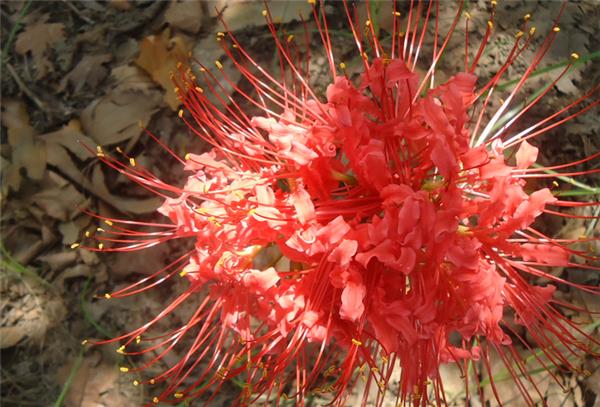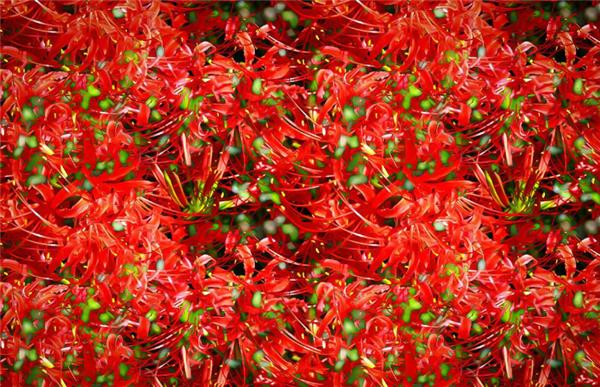[planting technology of flowers on the other side] how to raise flowers on the other side
According to the old legend, the Manzhu Shahua on the other side of the road represents the flower of death. Of course, there are only legends. There are still many people who want to raise flowers on the other side. Today, let's take a look at the planting methods and points for attention of the flowers on the other side.

First, the planting technology of the other shore flower.
The breeding method of the other shore flower is very simple, peeling off the bulbs around the main bulb of the other bank flower to propagate. Trim the residual root of the cue ball and plant it after the wound is dry. Potted plant choose to grow for 3 years, can blossom big ball (diameter is more than 7 meters) potted plant, can plant one ball per pot. It should be planted shallowly, so that the 1 stroke of the ball resides on the soil surface. Water the soil once after putting on the basin to make the soil slightly moist. Wait for the new leaves to be watered. Liquid fertilizer was applied once every half month. Wait for 2 ~ 3 months, after budding, and then turn the basin or change the basin soil. Watering should be less in summer dormant period, and basin soil should be kept moist in spring and autumn. Sparse pancake fertilizer and water were applied every half month during the growing season. Garlic likes semi-shade, avoid direct sunlight in summer, maintain semi-shady place in spring and autumn, strictly control watering and stop fertilization during overwintering. Common pests are: Spodoptera litura, Lycoris radiata, thrips, grubs. Post-anthesis treatment and pest control Lycoris should cut off the scape after flowering in order to reduce the loss of nutrients.
The planting depth of the other shore flower should not be too deep, and the top of the bulb should be just buried in the soil. The soil quality requires sandy soil or loose cultivated soil with good drainage. During the vegetative growth period, we should often irrigate, and we must have an appropriate amount of water supply from 20 days before flowering to the flowering stage, so as to achieve neat and consistent flowering, and the flowers are easy to maintain. Keep the soil moist, but do not accumulate water to prevent the bulbs from rotting.

Second, the potted method of the other shore flower.
The other shore flower likes scattered light and does not like strong light, so the light should not be too strong. The flowers on the other side usually have no requirements for soil. But after all, it is a southern flower, so the soil should be acidic, a little sandy, breathable and permeable. The other shore flower has ornamental value all the year round, with leaves but no flowers, flowers without leaves.
Lycoris has strong adaptability, the bulb has dormancy, the north needs potted ornamental, and the Lycoris planted at the end of May should also be able to blossom. The suitable time for cultivation in the north: it should be planted in spring (April-May). Most varieties like warm climate, the maximum temperature is no more than 30 ℃, the ten-day average temperature is 24 ℃, which is suitable for the growth of Lycoris radiata. After sowing for 10 days, the root system grew vigorously and the leaves grew out of the ground successively. In winter, the daily average temperature is more than 8 ℃, and the lowest temperature is 1 ℃, which does not affect the growth of Lycoris radiata. It should not be watered too much, or it will rot the rhizome.

Third, the management after planting the other shore flower.
Topdressing: watering the soil once after putting on the basin to make the soil slightly moist. Wait for the new leaves to be watered. Liquid fertilizer was applied once every half month. The planting of the other shore flower can stop watering when the leaves are thickened and mature in autumn. Wait for 2 ~ 3 months, after budding, and then turn the basin or change the basin soil. The cultivated soil can be mixed with 2 parts of peat, 2 parts of garden soil and 1 part of perlite, with a small amount of base fertilizer added. The planting of the other shore flower should be watered less during the summer dormancy period, and the basin soil should be kept moist in spring and autumn. Sparse pancake fertilizer and water were applied every half month during the growing season. The planting of the other shore flower likes the semi-shade, avoids direct sunlight in summer, maintains the semi-shady place in spring and autumn, strictly controls watering and stops fertilization during overwintering.
Prevention and control of diseases and insect pests: the scape of the other shore flower should be cut off after flowering to reduce the loss of nutrients. The planting management of the other shore flower is extensive, and the common diseases are anthracnose and bacterial soft rot. The bulb is soaked in 0.3% copper sulfate solution for 30 minutes before planting, washed with water and planted after drying. The planting of Bianhua is controlled by spraying 50% carbendazim wettable powder 500 times every half month. At the initial stage of the disease, 50% benzoate was sprayed with 2500 times solution.

Through the above introduction to the planting technology of the other shore flower, we have some understanding of the other shore flower. Interested friends can raise a pot of the other shore flower by themselves to add embellishment to their own living space.
Related
- Wuhan Hospital Iron Tree Blooming Result Was Instantly Frightened by the Gardener Master
- Which variety of camellia is the most fragrant and best? Which one do you like best?
- What is the small blue coat, the breeding methods and matters needing attention of the succulent plant
- Dormancy time and maintenance management of succulent plants during dormancy
- Minas succulent how to raise, Minas succulent plant pictures
- What are the varieties of winter succulent plants
- How to raise succulent plants in twelve rolls? let's take a look at some experience of breeding twelve rolls.
- Attention should be paid to water control for succulent plants during dormant period (winter and summer)
- Watering experience of twelve rolls of succulent plants
- Techniques for fertilizing succulent plants. An article will let you know how to fertilize succulent plants.



